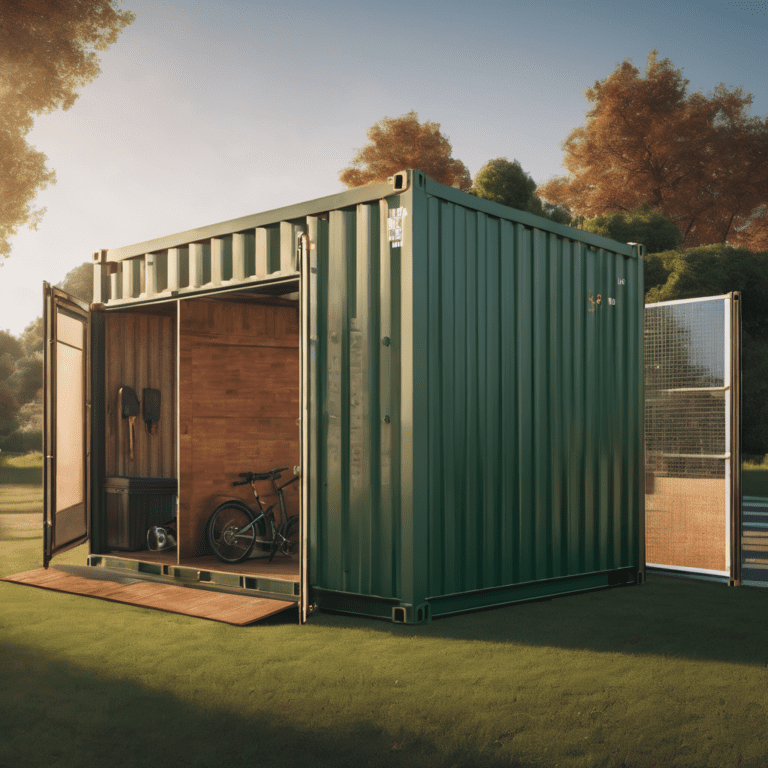How to Comply with Shipping Container Building Codes: A Complete Guide
Shipping container homes and structures have gained immense popularity as an affordable, durable, and sustainable option for housing, storage, and businesses. However, complying with shipping container building codes is essential to avoid legal complications and ensure safety. Regulations vary based on location, intended use, and modifications made to the container.
This guide will help you navigate local zoning laws, building permits, structural integrity safety, and electrical and plumbing codes while addressing key concerns about where you can place a shipping container, whether it’s considered a permanent structure, and what states allow shipping container homes.


1. Understanding Local Zoning Laws
The first step in complying with shipping container zoning laws is determining whether your local government allows containers for residential, commercial, or storage use. Zoning laws differ based on the city, county, and state, so checking with local authorities is crucial.
✅ Key Zoning Law Considerations:
- Can I put a shipping container on my property? Check your city’s planning and zoning office to see if your area allows shipping containers for housing, storage, or commercial use.
- Are container homes legal in California, New York, or Florida? Each state has different regulations. Some classify container homes as prefabricated homes, while others require full compliance with local residential building codes.
- Where can I put a container home? Some areas allow shipping containers as accessory structures, while others require a full residential building permit and adherence to International Residential Code (IRC) standards.
- Do I need a permit for a shipping container on my property? If your container will be used as a permanent structure, a building permit application will likely be required.
🔹 Additional factors that could impact zoning approval include:
- Lot coverage restrictions
- Height restrictions for accessory structures
- Flood area regulations
- HOA rules and deed restrictions
📌 Pro Tip: If you live in a planned community or HOA-governed neighborhood, check for any aesthetic restrictions or paint color requirements that could impact your container placement.
2. Obtaining the Right Permits for a Shipping Container
Do You Need a Permit for a Shipping Container?
A shipping container permit is often required, especially if you plan to use the container as a living space, office, or commercial structure. Temporary storage containers may be exempt in some areas but still require a temporary use permit.
🔹 Common Permit Requirements:
- Building permit application submitted to the local government.
- Site plans showing the intended location of the container.
- Structural engineer approval for modifications such as windows, doors, or additional support.
- Fire safety measures, including compliance with California Fire Code in wildfire-prone areas.
- Energy efficiency compliance (some states, such as California, require solar panels or additional insulation).
- Foundation requirements to ensure structural stability.
📍 States like California, New York, and Florida have some of the strictest building codes, so ensure you comply with both state and municipal regulations before proceeding with your project
3. Ensuring Structural Integrity & Safety of a Shipping Container Home
Although shipping containers are designed to endure harsh transportation conditions, modifications for residential and commercial use can affect structural integrity safety.
🔹 Structural Safety Checklist:
✅ Reinforcement is required if you plan to cut openings for doors, windows, or ventilation.
✅ Containers must be anchored properly to prevent movement or structural collapse.
✅ Insulation standards must be met for temperature control, moisture prevention, and energy efficiency.
✅ Foundation requirements vary based on location but often include concrete slabs, piers, or footings to stabilize the structure.
✅ Hazardous materials storage restrictions may apply if the container was previously used for industrial transport.
💡 Structural engineer approval is typically required for major modifications to prevent integrity loss and ensure compliance with safety regulations.
4. Meeting Electrical and Plumbing Codes
If you are turning your shipping container into a home or office, it must comply with electrical and plumbing codes to pass inspection.
✅ Electrical System Compliance:
- Must meet the National Electrical Code (NEC).
- Proper grounding and circuit protection are mandatory.
- Some states require solar panels for energy efficiency compliance.
✅ Plumbing Code Requirements:
- Sewage and drainage must align with municipal regulations.
- Water heaters and pipe insulation should comply with local climate codes.
- A permit is required for major plumbing modifications.
🚨 If electrical or plumbing work is done incorrectly, it can result in denied inspections, penalties, or unsafe conditions.
5. Fire Safety & Accessibility Requirements
Fire safety and accessibility standards must be met, particularly for shipping container homes in California, which have some of the strictest regulations.
🔹 Fire Safety Requirements:
- Fire-resistant insulation and coatings may be required in some states.
- Smoke and carbon monoxide detectors must be installed if the container is used as a dwelling.
- California Fire Code compliance is required in high-risk areas.
🔹 ADA & Accessibility Regulations:
- Commercial shipping container structures must comply with ADA requirements for entryways, ramps, and door sizes.
- Emergency exits may be required if the structure is used for public access.
6. Can You Put a Shipping Container in Your Backyard?
One of the most common questions is “Can I put a shipping container in my backyard?” The answer depends on:
- Local zoning laws – Some allow it for storage, while others prohibit residential use.
- Homeowners’ association (HOA) restrictions – Many communities have visual mitigation requirements.
- State laws – Some states require compliance with prefabricated home codes.
📌 If you’re in Florida or California, you may need additional approvals related to flood area regulations and energy efficiency requirements.
FAQs About Shipping Container Building Codes
Do I need a permit to put a shipping container on my property in Florida or California?
Yes. Both states have strict building permit requirements, and California often requires compliance with the California Building Code.
Is a shipping container considered a permanent structure?
If placed on a foundation and used for housing or business, it is typically classified as a permanent structure and must comply with all building regulations.
Are shipping container homes legal in New York?
Yes, but they must meet the New York State Residential Code, which includes strict insulation and energy efficiency requirements.
What are the foundation requirements for a shipping container?
Common options include concrete piers, slabs, or anchored footings, depending on soil conditions and local building codes.
Can I live in a shipping container home full-time?
Yes, but you must obtain a certificate of occupancy after passing all necessary inspections.
Internal Links to Explore Further
- Do You Need a Permit for a Shipping Container Home? Everything You Need to Know
- Shipping Container Zoning Laws by State: A Complete Guide for Homeowners & Businesses
- Complete Guide: Shipping Container Zoning Laws in All 50 States
- Best Locks for Shipping Containers: Protect Your Cargo with High-Security Solutions
- Best Shipping Container Security Camera Systems: 24/7 Surveillance & Remote Monitoring
- How to Burglar-Proof a Shipping Container: The Ultimate Security Guide
- Fire Safety Tips for Shipping Container Storage
- Shipping Container Fireproofing Methods: Protecting Your Fire-Resistant Storage and Living Spaces
- Insurance for Shipping Container Homes: Everything You Need to Know
- Seismic Safety for Shipping Container Structures: The Ultimate Guide to Earthquake-Resistant Designs
- Are Shipping Containers Safe to Live In?
- Are Shipping Containers Waterproof?
Get quote!

No strings attached 💯